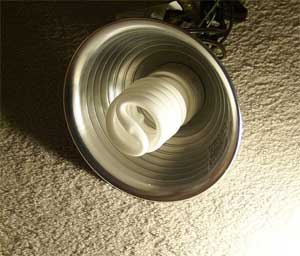Mercury is nasty stuff. It is a neurotoxin, which is a poison that attacks nerve cells. (By the way, the venom of puffer fish and some snakes, spiders and scorpions are also neurotoxins these critters use to either capture prey or keep from being preyed upon.)
 |
| A Compact Fluorescent Light (CFL) bulb can have about 4 milligrams of mercury sealed within the glass tubing. Compare that to an older thermometer contains about 500 milligrams of mercury, which equals 125 CFLs. Some newer CFLs have 1.4-2.5 milligrams. Because CFLs use less electricity than incandescent bulbs, less fossil fuel is burned, so the end result is less mercury in the environment if CFLs are properly disposed of. Dean Jenkins photo. |
When products that contain mercury are burned, mercury vapors can be released into the outside air. When it rains, that mercury can come back down to earth again. Rainwater containing even miniscule amounts of mercury is a problem, because mercury bioaccumulates in living tissues.
Bioaccumulation happens when tiny organisms absorb a little bit of something like mercury and it stays in their bodies. Then bigger organisms eat lots of the tiny organisms. Then even larger organisms feed on them, and so on, until the levels of mercury build up to toxic levels.
After studies done on smallmouth bass found there can be significant amounts of mercury in their bodies, the Connecticut State Department of Health (DPH) issued health advisories regarding consumption of fish. This doesn’t mean you should not fish or eat fish – fish is good for you in other ways. But people should not eat freshwater fish from local waters more than once a week. The DPH also suggests that pregnant woman and children under the age of six limit their fish eating to one meal per month. There are exceptions to this advice. See the DPH recommendations at http://tinyurl.com/75tgmy for more information.
Studies have also been done to figure out where the mercury found in fish and other creatures is coming from. It turns out that significant amounts of mercury blow here on wind currents from distant coal-burning power plants. (Almost 50% of our nation’s electricity comes from coal.) New England states and New York have banded together to try to reduce this contamination by 1) jointly adopting a Total Maximum Daily Load for atmospheric mercury, and 2) trying to persuade the federal government to do more to protect our water resources from this contamination source which affected States have no control over.
There are things we citizens can do to reduce mercury contamination in the environment. Number one is to reduce the amount of electricity we use, so there is less demand for power from coal burning power plants. One way to do that is to use compact fluorescent light bulbs (CFLs). CFL’s use a fraction of the amount of electricity of an incandescent bulb to produce the same amount of light.
Ironically, CFLs (and some other common household items) contain mercury. That’s why you should not burn a CFL bulb, or dispose of it in trash that will end up in an incinerator. In 2006 in Connecticut, 79.34% of disposed municipal solid waste was burned at CT trash-to-energy plants in Hartford, Bristol, Bridgeport, Wallingford, Preston and Lisbon (Source: CT DEP).
Therefore, CFLs need to be separated from household trash and disposed of as hazardous waste. Some town transfer stations may be equipped to collect fluorescent light bulbs - check with your town. Maybe the brightest bulbs on the planet will come up with an even better technology by the time you need to dispose of your long-lasting CFL bulbs. In the meantime, learning what not to burn can help reduce mercury levels in the environment that could eventually end up in your dinner.
See next week’s article for how to identify and properly manage items that contain mercury.
Archived articles can be found at www.ourbetternature.org Visit the Thames River Basin Partnership website at www.trbp.org |

